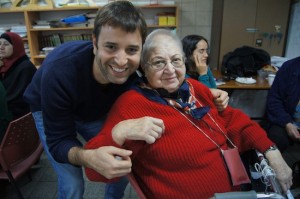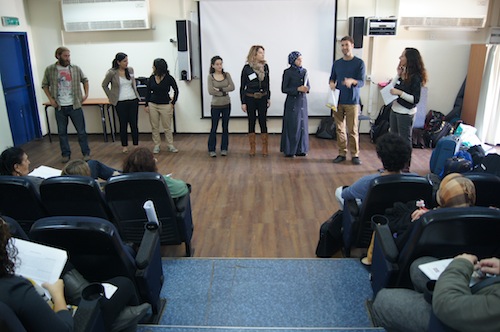Mahapach-Taghir’s national coordinator Itamar Hamiel and Palestinian co-director Fidaa Nara Abu-Dbai at the organization’s last residents conference in Tel Aviv. (photo from Itamar Hamiel)
On June 10, Itamar Hamiel of Mahapach-Taghir will be in Vancouver to speak about his organization and new models of activism focused on the Israeli peripheria, the socioeconomic and geographic fringes of the country.
Sponsored by New Israel Fund of Canada (NIFC) and hosted by Temple Sholom Synagogue, the lecture is the latest in a series of NIFC events in the city. Mahapach-Taghir, a project that NIF supports, defines itself as a feminist, grassroots, Jewish-Arab organization that focuses on education and community development. Its origins are in the Israeli students’ tuition strike of 1998, with a group of students from the Hebrew University of Jerusalem. Believing that social change must go beyond themselves and also include marginalized communities, they began volunteering in the Katamonim neighborhood in Jerusalem, eventually establishing an after-school education and mentoring program. This program grew into Mahapach-Taghir’s first “learning community,” which has been replicated in eight neighborhoods across Israel, and remains the organization’s core program.
In anticipation of his visit, the Independent spoke with Hamiel, who is Mahapach-Taghir’s national coordinator.
JI: What is the relationship between NIF and your organization?
IH: NIF has supported Mahapach-Taghir since our founding in 1998…. Our organization is sometimes hard to understand: we are a feminist, grassroots, Jewish-Arab organization that focuses on education and community activism. Because of this, sometimes it is hard for us to find funding from foundations that have more specific focus. NIF understands this complexity and supports us in it. Because we insist on Jewish-Palestinian partnership on all levels of our organization, some Jewish foundations aren’t interested in our work. They have a narrow view of what supporting Israel means, and NIF breaks that mold.
Around 14 percent of our funding from last year was from NIF, but our experience is that long-term support is more critical than the amount of funding, and NIF has provided that.
JI: How did you become involved in Mahapach-Taghir?
IH: I became involved in Mahapach-Taghir around 15 years ago, a few months after it was established, as a student volunteer in our community in Florentine (Tel Aviv). After the students in Jerusalem founded the organization in Katamonim, they decided to open communities around the country, including in Florentine.
I saw an ad in the university library and thought it looked interesting – 15 years later, I still haven’t left. I was a student volunteer, a coordinator, a board member, and now work on the national staff. Mahapach-Taghir became my “ideological home.” I know many organizations that focus on feminism, Jewish-Arab partnership, community work, etc., but there are no other organizations that combine these inherently interconnected issues in the way that Mahapach-Taghir does.

JI: Looking at the staff list on the website, all of the staff are women except for you. What are your thoughts on leading a feminist organization?
IH: I am here representing Mahapach-Taghir, but I wouldn’t say that I lead the organization, and I don’t think it would be right if I did. Our Palestinian co-director is Fidaa Nara Abu Dbai and we are currently looking for a Jewish co-director. I won’t even apply for that job because I don’t believe a man should lead an organization that is comprised primarily of women. Usually, even in civil society, most of the staff and volunteers are women and the directors are still men. We believe that it is important to break that paradigm.
JI: How does the Jewish-Arab aspect of the organization get expressed?
IH: Our communities come together for national conferences and seminars at least six times a year. One of our communities is a mixed Jewish-Arab community and, in our communities that are not mixed, there are partnerships between Jewish and Arab communities in geographic proximity.
Mainly, though, we do not think that the only way to do Jewish-Palestinian partnership work is through direct meetings…. For example, in Jerusalem, the Mahapach-Taghir activists in Kiryat HaYovel started a project called Second Opportunity, in which women who had no high school degree were able to pursue a bachelor’s degree. This might not seem political but through Mahapach-Taghir, they drew the link between their lack of education and the political marginalization they face as women in a Mizrahi community. They also understand the link between their marginalization and that of Palestinian women in Israel. The women shared their project with the rest of the communities in a national event, and that inspired the women from Tamra (a Palestinian town inside Israel) to start their own version of the project where the graduates from Jerusalem will serve as mentors. For me, this is the true meaning of partnership: each community works for its own empowerment, while acknowledging the rights and needs of other communities and inspiring one another. They work in solidarity.
JI: What is the feminist aspect of the learning communities? Are fathers also invited to participate?
IH: Each learning community is led by a steering committee that is comprised of residents, almost all of whom are women. We didn’t set out to exclude men but, when you talk about education and community empowerment, women tend to show up. The students who founded Mahapach-Taghir didn’t set out to establish a feminist organization but their view of social justice, and the fact that most of the activists that got involved were women, made it clear that feminism is one of our core values. The very fact that even today when we open a new community it is women who show up, confirms this value. Being a feminist organization doesn’t necessarily mean excluding men, but this country will be a better place when more women have active leadership roles.

JI: Organizations focusing on community development, education and youth take a long view of social change compared to political groups. Why have you chosen this form of activism?
IH: Your question assumes a dichotomy between political and social change. We in Mahapach-Taghir see community development, education and youth work as highly political. Especially in the Israeli context there is a separation between talking about the Israeli-Palestinian conflict (political) and doing work in marginalized communities (social). As always in Mahapach-Taghir, we see this holistically. These issues are interconnected and we need to engage with them as such.
For this reason, we use this form of activism. We have a long view of social change and want to support communities in engaging in activism that will improve the lives of their families, communities and eventually their societies more generally while encouraging solidarity between Jews and Palestinians inside Israel.
JI: Are there measurable outcomes from Mahapach-Taghir’s learning communities?
IH: There are many measurable outcomes from our learning communities but the most important outcomes are not easy to measure. How do you measure empowerment, solidarity and sense of community? In recent years, the perspectives of the corporate world have increasingly influenced expectations of civil society. Organizations like Mahapach-Taghir are expected to provide products and measurable outcomes, and I think that this view is mistaken. I understand that foundations want to know if their money is being well spent but I don’t think that social change can be measured so easily. I am happy to share countless success stories. We can see changes in the communities where we work and in the activists and students that we work with. The stories that are most exciting are usually from activists who have been involved for many years and have gone through a slow but meaningful process of change.
JI: You are coming to Vancouver to solicit donations for NIF from the Diaspora Jewish community. Do you also do resource development in the Arab community (either locally or in the Diaspora)?
IH: Most of our funding comes from European foundations, not from the Jewish Diaspora. We hope that this will change and that more Diaspora Jews will see the value in our work. We also do fundraising locally in each of our communities because we believe in the value of sustainability and local partnership. We have had much more success doing this in our Arab communities. Last year, we raised over 50,000 shekels from our local communities and most of this was from our Arab communities.
JI: What do you hope to share with the Jewish community in Vancouver?
IH: I want to share with them a complex understanding of the society in Israel. I see the tension that Diaspora Jews face of feeling the need to be either “with us or against us,” but I believe that supporting Israel means supporting a more democratic, diverse, pluralistic society in Israel. I hope to bring the voice of our activists, who are doing incredible work in their communities, Jewish and Palestinian, marginalized communities around the country.
Maayan Kreitzman is a freelance writer living in Vancouver.
***
To register for the June 10 event at Temple Sholom, which starts at 7 p.m., go to nifcan.org/our-events/upcoming. In addition to Hamiel, NIFC has invited a local counterpart in community building as a parallel to the work being done in Israel: Lindsay Vander Hoek of Mission Possible will describe her organization’s work with residents of Vancouver’s Downtown Eastside.

